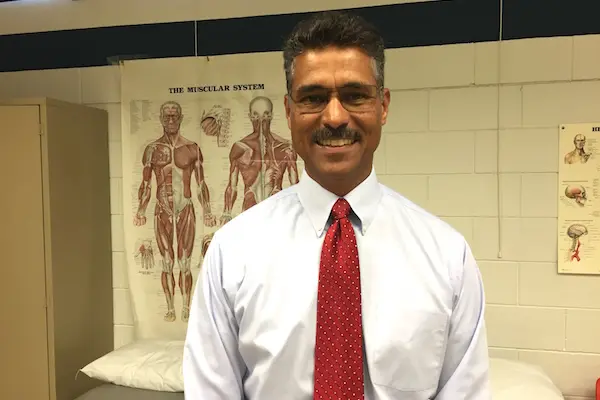Bodies are Built to Move

08/30/2018
By Karen Angelo
Chances are, you’re reading this sitting down. Get up! Your aching back will thank you.
About 80 percent of adults experience lower back pain at some point in their lifetimes, according to the National Institutes of Health. It is the most common cause of job-related disability and a leading contributor to missed work days.
Edgar Torres, clinical associate professor in the Department of Physical Therapy and Kinesiology, specializes in orthopedics and sports medicine. His 27-year career as a teacher and clinical physical therapist includes five years in the military treating soldiers.
Torres says that in his experience, while there may be one incident that patients point to when they come in for treatment, the cause of back pain is typically a culmination of little things. What can be done to avoid those little things and keep back trouble – from random twinges to debilitating pain – at bay? Torres lends his expertise on how to keep our backs healthy.
Q: What should every person, young and old, know about body mechanics?
A: The way I look at the human body is similar to how a car operates. For example, the discs in our spines are full of fluid that act as shock absorbers. How do we keep that fluid healthy? By moving. If your car sits in the driveway for a long period of time, chances are the car won’t operate correctly. Likewise, if we live a sedentary lifestyle, our body mechanics break down. Our bodies are built to move.
Q: What’s happening to our bodies when we sit for long periods of time?
A: Sitting in one place weakens our back. Some of our back and trunk muscles and ligaments become overly stretched, and some are overly shortened. This leads to imbalances. The extra stress from sitting decreases the back’s shock-absorbing capacity. Over time, this can lead to long-term pain.
Q: What kind of movement or exercises do you recommend to help or prevent back pain?
A: The right exercise program is the one that you will do. Too many people start strong on a program and then it fizzles out. When we are static, our bodies produce waste products within muscles, joints and other structures that are not readily removed. We become stiff, and movement becomes more difficult. This is easily noticed when we first wake up in the morning. We usually have more difficulty with movement first thing in the morning. As we perform our daily activities, movements become easier.
I recommend walking, because no special equipment is needed. When we walk, our whole body system is moving – the spine, arms, knees, hips and joints. Since our joints contain fluids, the more we move, the more we lubricate our joints, which will ease or prevent pain. Running also works for many people, although there is more stress on our joints with running compared to walking.
Even if you stick to a regular exercise program, I recommend integrating movement into your daily schedule, especially if you sit most of your day in front of a computer.
Q: What integrated activities do you recommend?
A: If you work at a desk, you should set alarms to get up at least every half hour. Don’t slouch. Keep a straight posture and make sure your desk, chair and computer are ergonomically correct. Make sure you have a chair with good lumbar support. Place sticky notes on your computer to remind you to get up and move. Make a habit of standing while on conference calls or when someone texts or calls you. Do basic movements such as walking in place. Put two hands on the lower part of your back, bend slightly backwards and look up at the ceiling to counter the sitting position. Do this once every couple of hours. Most of us can avoid aggressive stretching and incorporate more movement-based stretching into our daily lives. You can also do things like park in the spot the farthest away from a store or your office and take the stairs.
Q: How important is warming up and stretching before an activity?
A: Imagine the components of your back – spine, muscle, discs and nerves – that need to work together to operate correctly. If you suddenly decide to pull weeds, swing a golf club or lift a heavy box, what will happen if you haven’t warmed up and stretched those muscles? Movement quality will be compromised, and the potential to cause pain increases. And this is not just for people who are aging.
In my own experience, I’ve had back pain since I was young. I worked on a farm doing all kinds of physical work. I was also an athlete. Unfortunately, I always had back pain and still do to this day. But I am still active and manage my pain. I manage it by doing things like arriving 30 minutes before my golf tee time to warm up. This may not work for everyone, so find what works best for you.
Q: Is there a cure for back pain?
A: Our society wants a pill, a quick solution. Generally, there isn’t one. We can’t stop the aging process. However, we can change our posture, build strength and increase activity. If you have aging-related degenerative discs, you can still get stronger by using weights and bands with guidance from a physical therapist or other health care professional. The pain might not go away entirely, but you can manage back pain and live an active lifestyle. Don’t let the pain manage you.
